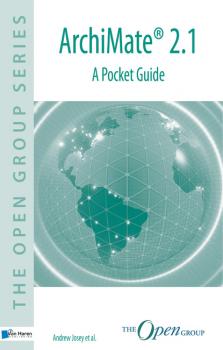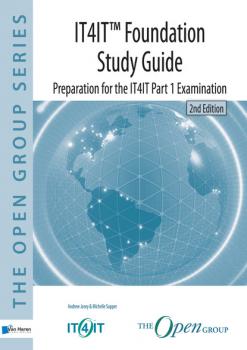ТОП просматриваемых книг сайта:
Andrew Josey
Список книг автора Andrew JoseyАннотация
This title is a Study Guide for the IT4IT Foundation Certification examination. It gives an overview of every learning objective for the IT4IT Foundation certification syllabus and in-depth coverage on preparing and taking the IT4IT Part 1 Examination. It is specifically designed to help individuals to prepare for certification.This Study Guide is excellent material for: Individuals who require a basic understanding of the IT4IT Reference Architecture IT Professionals/Practitioners who are responsible for delivering services in a way that is flexible, traceable, and cost-effective IT Professionals who want to achieve a higher level certification in the IT4IT Certification Program (expected in 2017) in a stepwise approachA prior knowledge of IT service management is advantageous but not required. While reading this Study Guide, the reader should also refer to the IT4IT documentation available at www.opengroup.org/it4it
Аннотация
Note: This book is available in several languages: Brazilian Portuguese, English, Spanish, French.Ce Guide de Poche se base sur TOGAF® Version 9.1 Entreprise Edition et il fait autorité en la matière car il en reprend des éléments de documentation.En introduisant de manière concise TOGAF®, sa lecture ne nécessite pas d'avoir des connaissances préalables sur l'architecture d'entreprise.Ce livre vous est principalement destiné si vous êtes un professionnel concerné par l'architecture: architecte d'entreprise, architecte métiers, architecte des systèmes d'information, architecte des données, architecte systèmes, architecte solutions ou dirigeant cherchant une première introduction à TOGAF®.Ce guide de Poche fournit les éléments suivants: une présentation générale de TOGAF®; une introduction à la Méthode de Développement d'Architecture; une introduction aux notions de Cadre de Contenu d'Architecture et de Continuum d'Entreprise; une introduction au Cadre de Capacité d'Architecture, permettant de créer et de mettre en oeuvre une fonction d'architecture au sein d'une entreprise.Avec plus de 30.000 praticiens certifiés dans le monde, TOGAF® est le cadre d'Architecture d'Entreprise le plus répandu dans les entreprises. Il s'appuie sur une approche itérative de transformation de l'entreprise qui couvre: le cycle de vie complet des architectures produites, de la vision à la maintenance, en s'attachant à livrer aux acteurs concernés la valeur métier et les qualités attendues; et le développement continu de la capacité à faire de l'Architecture d'Entreprise.TOGAF® a pour objectifs d'améliorer l'agilité et la performance de l'entreprise, de permettre l'innovation et l'émergence de nouveaux business models, de maîtriser la transformation de l'entreprise.TOGAF® est un standard de The Open Group et il a bénéficié de la mise en commun et de la coordination des bonnes pratiques de plusieurs centaines d'entreprises des domaines IT et industriels.
Аннотация
This Pocket Guide provides a concise introduction to the IT4IT Reference Architecture, Version 2.0, an Open Group Standard. The IT4IT standard provides a vendor-neutral, technology-agnostic, and industry-agnostic reference architecture for managing the business of IT, enabling insight for continuous improvement.This Pocket Guide is based on the IT4IT Reference Architecture Version 2.0. Whats more, its authoritative with material derived from the official IT4IT documentation and contributions from members of the IT4IT Forum.The audience for this Pocket Guide is: Individuals who require a basic understanding of the IT Value Chain and IT4ITReference Architecture IT Professionals who are responsible for delivering services in a way that isflexible, traceable, and cost-effective IT Professionals / Practitioners who are focused on instrumenting the ITmanagement landscape IT leaders who are concerned about their operating model Enterprise Architects who are responsible for IT business transformationTopics covered include: An introduction to the IT4IT Reference Architecture, the structure of the IT4ITstandard, and the positioning of the IT4IT standard in the standards landscape The IT Value Chain and IT4IT Reference Architecture concepts, including Value Streams The Strategy to Portfolio (S2P) Value Stream The Requirement to Deploy (R2D) Value Stream The Request to Fulfill (R2F) Value Stream The Detect to Correct (D2C) Value Stream A summary of the differences between the IT4IT Reference Architecture and ITIL
Аннотация
ArchiMate®, an Open Group Standard, is an open and independent modeling language for Enterprise Architecture that is supported by different tool vendors and consulting firms. The ArchiMate language enables Enterprise Architects to describe, analyze, and visualize the relationships among architecture domains in an unambiguous way.This Pocket Guide is based on the ArchiMate® 3.0 Specification. It gives a concise introduction to the ArchiMate language. What’s more, it’s authoritative with material derived from the official ArchiMate documentation.Topics covered include:• A high-level introduction to the ArchiMate Specification and its relationship to Enterprise Architecture• The high-level structure of the ArchiMate language, including an introduction to layering, and the ArchiMate Framework• The Generic Metamodel for the language• The relationships that the ArchiMate language includes to model the links between elements• The Motivation Elements, which includes concepts such as goal, principle, and requirement• The Strategy Elements, which includes concepts such as resource, capability, and course of action• The Business Layer, which includes the modeling concepts relevant in the business domain• The Application Layer, which includes modeling concepts relevant for software applications• The Technology Layer, which includes modeling concepts relevant for system software applications and infrastructure• The Physical Elements, which include concepts relevant for the modeling of physical concepts like machines and physical installations• The relationships between different layers of the language• The Implementation and Migration Elements, which include concepts to support modeling Enterprise Architecture-enabled transformation• A summary of the changes from ArchiMate 2.1 to ArchiMate 3.0• A Glossary of terms
Аннотация
Note: This book is available in several languages: Brazilian Portuguese, English, Spanish, French.This is the official Open Group Pocket Guide for TOGAF Version 9.1 and is published in hard copy and electronic format by Van Haren Publishing on behalf of The Open Group. TOGAF®, an Open Group Standard, is a proven enterprise architecture methodology and framework used by the worlds leading organizations to improve business efficiency. It is the most prominent and reliable enterprise architecture standard, ensuring consistent standards, methods, and communication among enterprise architecture professionals. Enterprise architecture professionals fluent in TOGAF standards enjoy greater industry credibility, job effectiveness, and career opportunities. TOGAF helps practitioners avoid being locked into proprietary methods, utilize resources more efficiently and effectively, and realize a greater return on investment.
Аннотация
ArchiMate®, an Open Group Standard, is an open and independent modeling language for Enterprise Architecture that is supported by different tool vendors and consulting firms. ArchiMate provides instruments to enable enterprise architects to describe, analyze, and visualize the relationships among business domains in an unambiguous way. This Pocket Guide is based on ArchiMate® 2.1. It gives a concise introduction to ArchiMate. Whats more, its authoritative with material derived from the official ArchiMate documentation.Topics covered include:– A high-level introduction to ArchiMate and its relationship to Enterprise Architecture;– The Business Layer, which includes the modeling concepts relevant in the business domain;– The Application Layer, which includes modeling concepts relevant for software applications;– The Technology Layer, which includes modeling concepts relevant for system software applications and infrastructure;– The relationships that the ArchiMate language includes to model the links between elements, and also the relationships to model the cross-layer dependencies;– The Motivation Extension;– The Implementation and Migration Extension;– The ArchiMate framework for defining and classifying ArchiMate viewpoints, including a summary of all the viewpoints in the ArchiMate 2.1 Standard;– The ArchiSurance Case Study, a fictitious example developed to illustrate use of the Modeling language in the context of the TOGAF Framework.Also available: ArchiMate® 3.0 Specification, ISBN 9789401800471
Аннотация
This is the official Pocket Guide for the TOGAF® Standard, Version 9.2, from The Open Group. It is published in hard copy and electronic formats by Van Haren Publishing. The TOGAF Standard, a standard of The Open Group, is a proven Enterprise Architecture methodology and framework used by the world’s leading organizations to improve business efficiency. It is the most prominent and reliable Enterprise Architecture standard, ensuring consistent standards, methods, and communication among Enterprise Architecture professionals. Those professionals who are fluent in the TOGAF approach enjoy greater industry credibility, job effectiveness, and career opportunities. The TOGAF approach helps practitioners avoid being locked into proprietary methods, utilize resources more efficiently and effectively, and realize a greater return on investment.
Аннотация
ArchiMate®, an Open Group Standard, is an open and independent modeling language for Enterprise Architecture that is supported by different tool vendors and consulting firms. The ArchiMate language enables Enterprise Architects to describe, analyze, and visualize the relationships among architecture domains in an unambiguous way.This Pocket Guide is based on the ArchiMate® 3.0.1 Specification. It gives a concise introduction to the ArchiMate language. What’s more, it’s authoritative with material derived from the official ArchiMate documentation.Topics covered include:• A high-level introduction to the ArchiMate Specification and its relationship to Enterprise Architecture• The high-level structure of the ArchiMate language, including an introduction to layering, and the ArchiMate Framework• The Generic Metamodel for the language• The relationships that the ArchiMate language includes to model the links between elements• The Motivation Elements, which includes concepts such as goal, principle, and requirement• The Strategy Elements, which includes concepts such as resource, capability, and course of action• The Business Layer, which includes the modeling concepts relevant in the business domain• The Application Layer, which includes modeling concepts relevant for software applications• The Technology Layer, which includes modeling concepts relevant for system software applications and infrastructure• The Physical Elements, which include concepts relevant for the modeling of physical concepts like machines and physical installations• The relationships between different layers of the language• The Implementation and Migration Elements, which include concepts to support modeling Enterprise Architecture-enabled transformation• A summary of the major changes from ArchiMate 2.1 to ArchiMate 3• A Glossary of terms
Аннотация
This title is a Study Guide for the IT4IT Foundation Certification examination. It gives an overview of every learning objective for the IT4IT Foundation certification syllabus and in-depth coverage on preparing and taking the IT4IT Part 1 Examination. It is specifically designed to help individuals to prepare for certification. This 2nd Edition of the document has been updated to align with the IT4IT Reference Architecture, Version 2.1.This Study Guide is excellent material for:• Individuals who require a basic understanding of the IT4IT Reference Architecture• IT Professionals/Practitioners who are responsible for delivering services in a way that is flexible, traceable, and cost-effectiveA prior knowledge of IT service management is advantageous but not required. While reading this Study Guide, the reader should also refer to the IT4IT documentation available at www.opengroup.org/it4it.
Аннотация
Ce Guide de Poche se base sur TOGAF® Version 9.2 Entreprise Edition et il fait autorité en la matière car il en reprend des éléments de documentation.En introduisant de manière concise TOGAF®, sa lecture ne nécessite pas d'avoir des connaissances préalables sur l'architecture d'entreprise.Ce livre vous est principalement destiné si vous êtes un professionnel concerné par l'architecture: architecte d'entreprise, architecte métiers, architecte des systèmes d'information, architecte des données, architecte systèmes, architecte solutions ou dirigeant cherchant une première introduction à TOGAF®.Ce guide de Poche fournit les éléments suivants:• une présentation générale de TOGAF®;• une introduction à la Méthode de Développement d'Architecture;• une introduction aux notions de Cadre de Contenu d'Architecture et de Continuum d'Entreprise;• une introduction au Cadre de Capacité d'Architecture, permettant de créer et de mettre en oeuvre une fonction d'architecture au sein d'une entreprise.Avec plus de 30.000 praticiens certifiés dans le monde, TOGAF® est le cadre d'Architecture d'Entreprise le plus répandu dans les entreprises. Il s'appuie sur une approche itérative de transformation de l'entreprise qui couvre:• le cycle de vie complet des architectures produites, de la vision à la maintenance, en s'attachant à livrer aux acteurs concernés la valeur métier et les qualités attendues;• et le développement continu de la capacité à faire de l'Architecture d'Entreprise.TOGAF® a pour objectifs d'améliorer l'agilité et la performance de l'entreprise, de permettre l'innovation et l'émergence de nouveaux business models, de maîtriser la transformation de l'entreprise.TOGAF® est un standard de The Open Group et il a bénéficié de la mise en commun et de la coordination des bonnes pratiques de plusieurs centaines d'entreprises des domaines IT et industriels.










